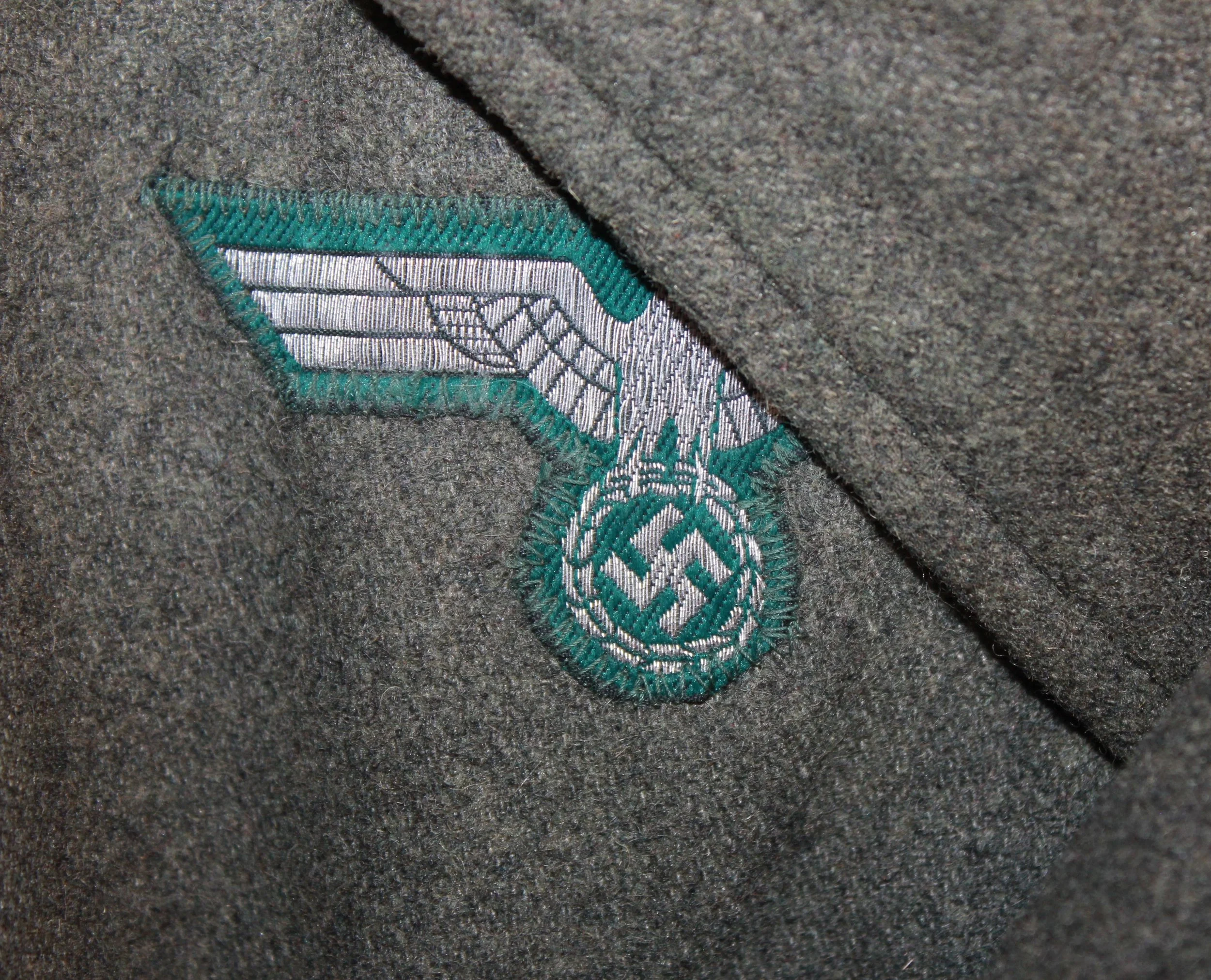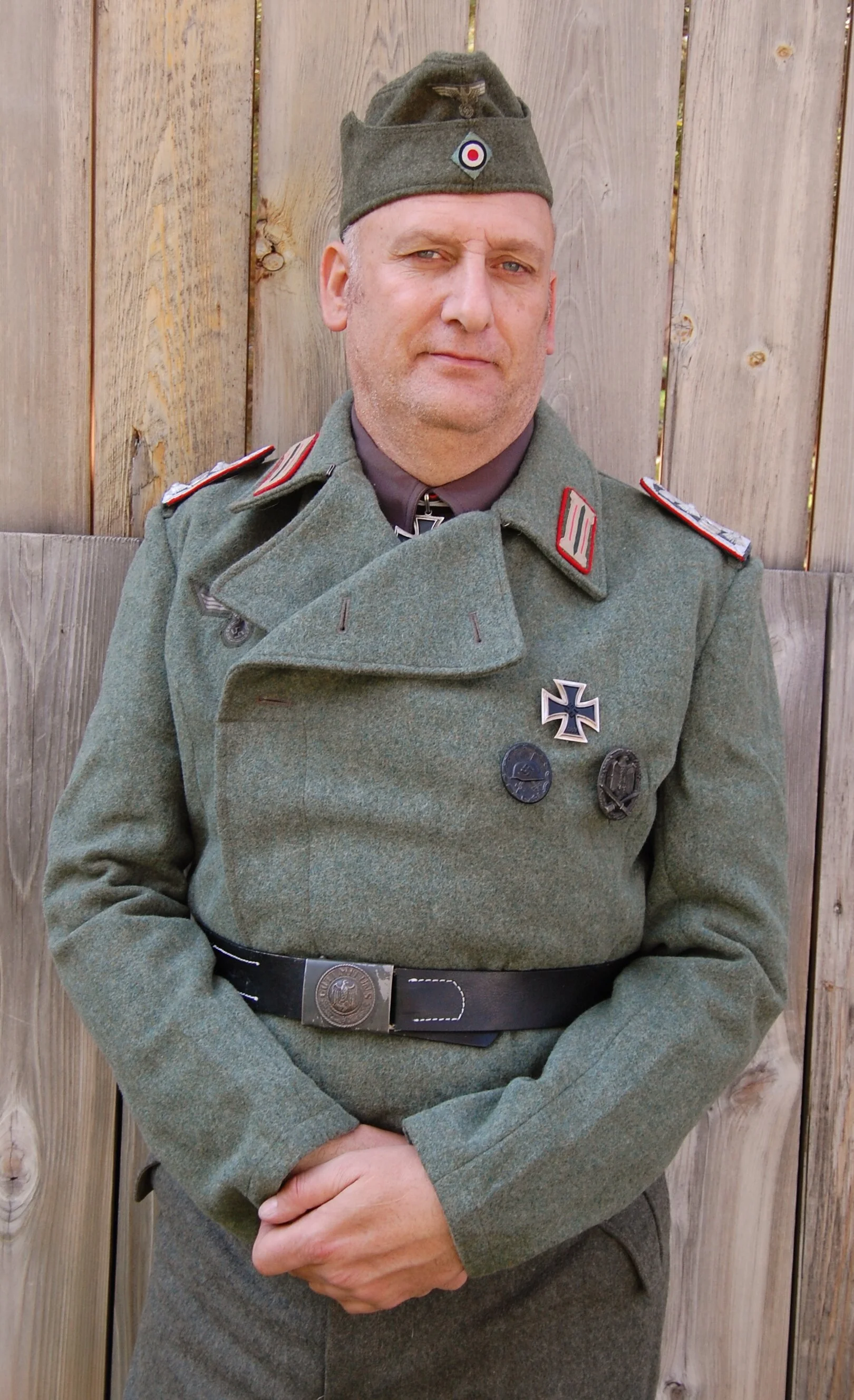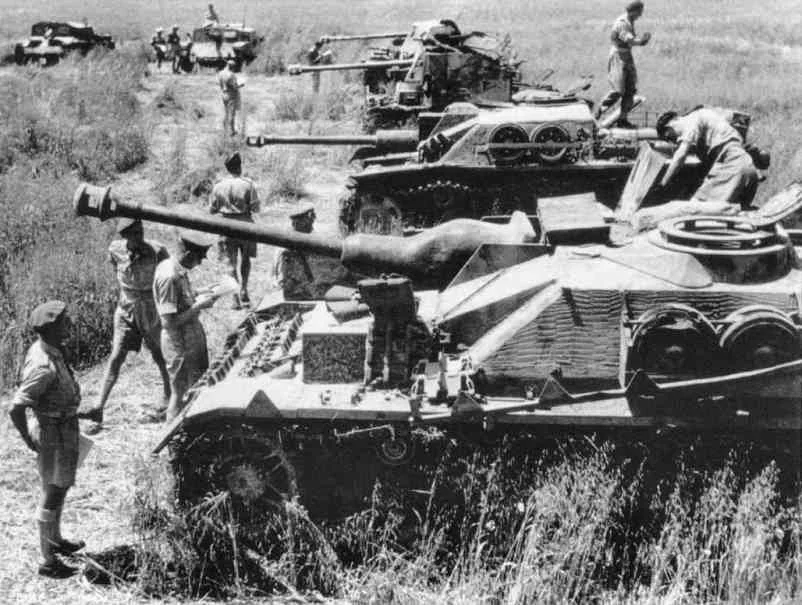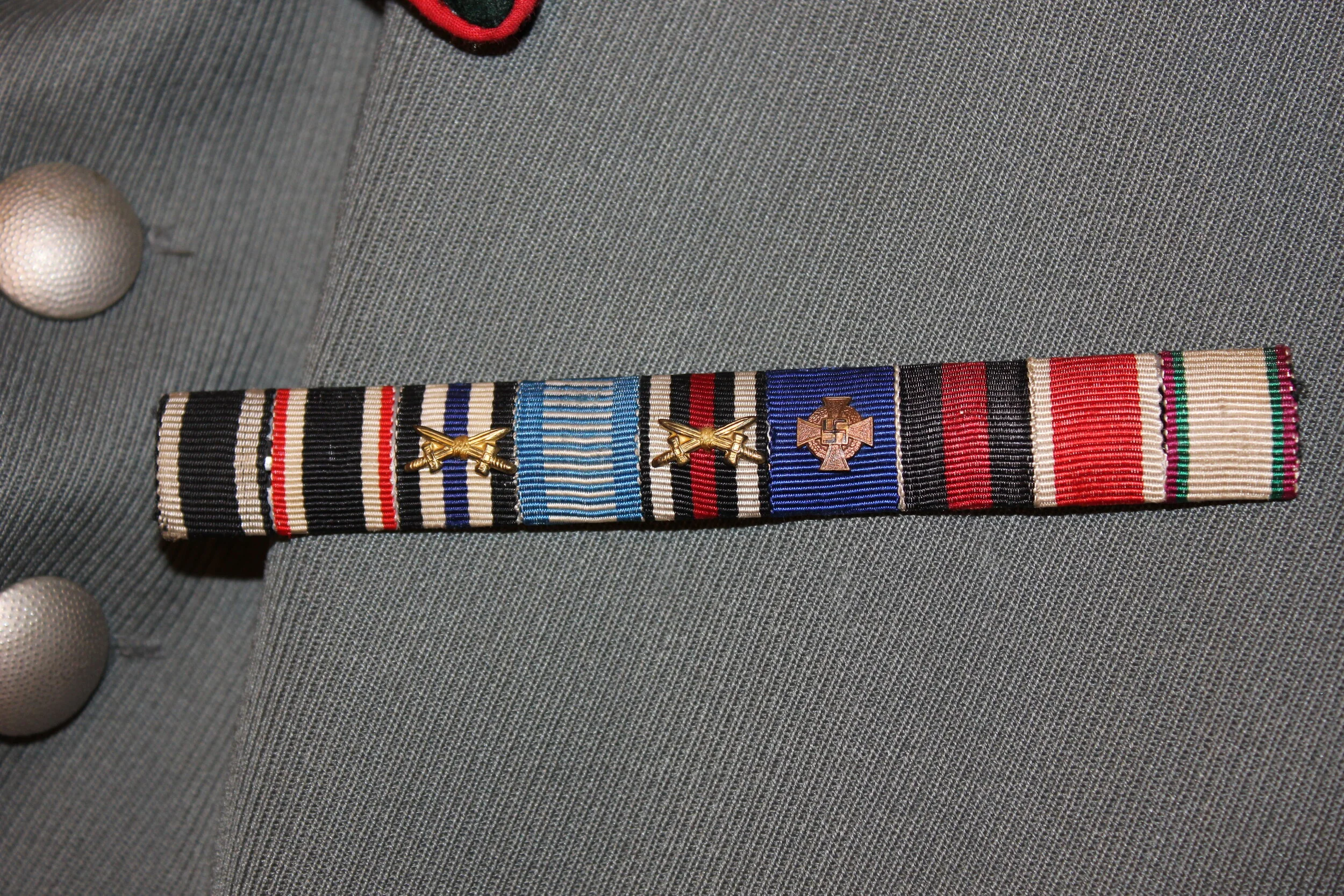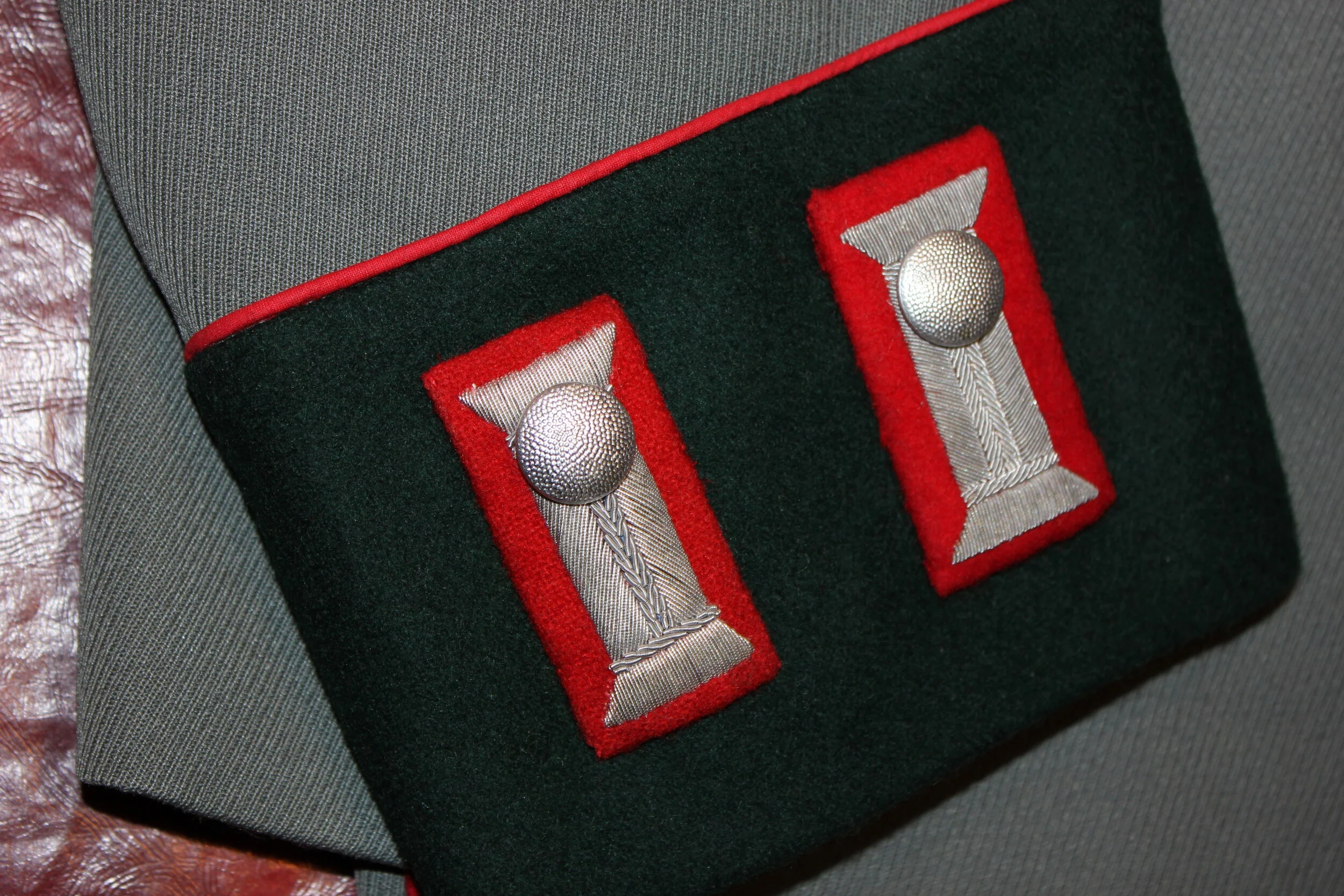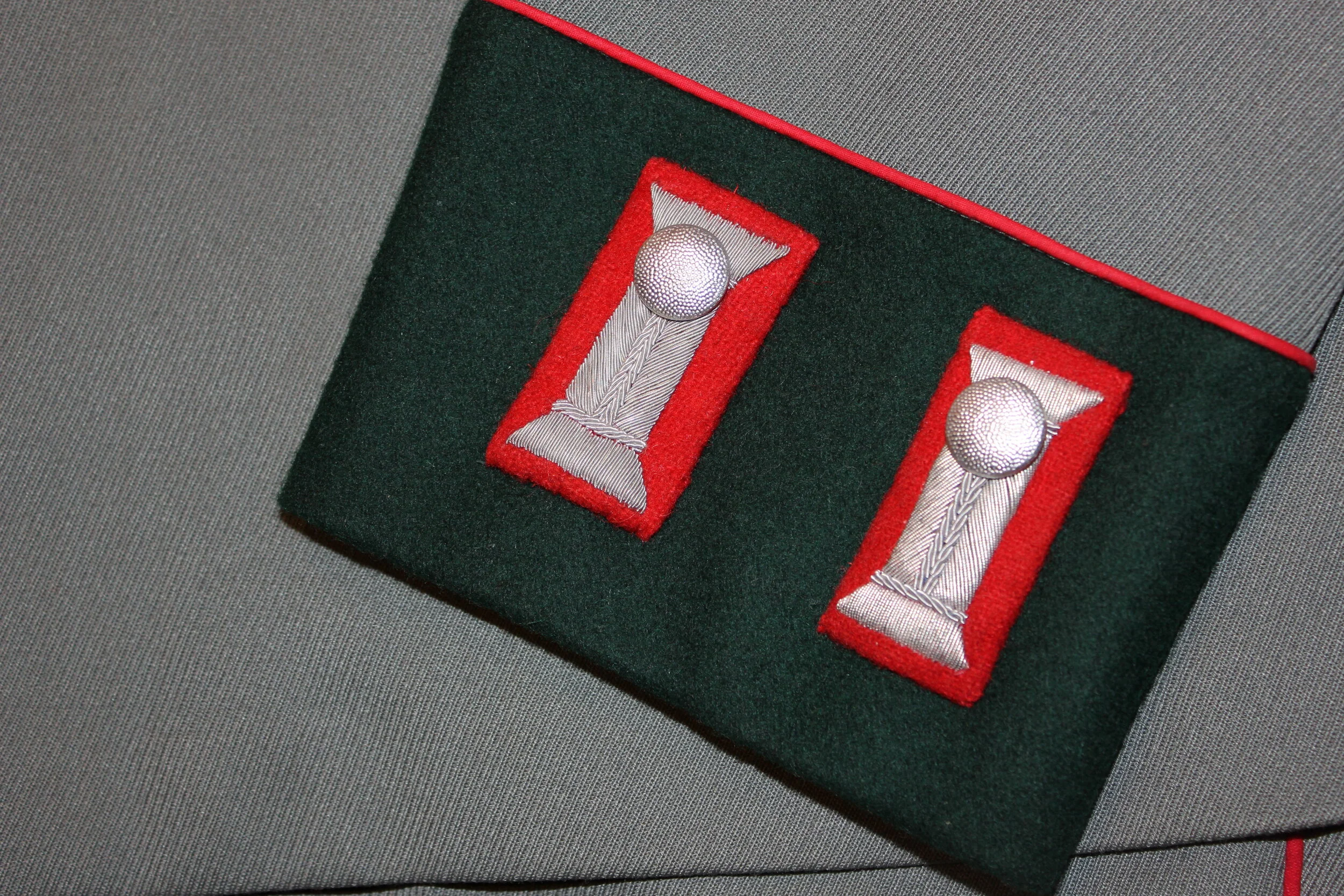Heer Assult Gun & Self-Propelled Artillery:
Leutnant, 1. Sturmgeschütz Abeilung 192:
Reichswehr Oberst Erich von Manstein spearheaded the use of special mobile armored artillery vehicles to directly support advancing Infanterie during 1935. These vehicles would reduce enemy fortifications, emplacements, and tanks by direct fire from a 75mm artillery piece. Development and subsequent training began in 1936 with units finally obtaining the long-awaited Sturmgeschütz III Ausf A in 1940. Sturmgeschütz Abteilung 192 was activated in November 1940 at Juterborg as Sturmartillerie Abteilung 192.
The Abteilung began a combat role with the beginning of Operation Barbarossa under the command of Infanterie Division 131. In the fall of 1941, the Abteilung became part of the Infanterie Division 124. In March 1942, the unit was dissolved and, along with the Abteilung 640, became the first battalion of the “Sturmgeschütz” integrated into the expanding ’Großdeutschland’ Division. Development of the Feldgrau Schutzmütz ran parallel with the production of a special uniform, patterned on the popular Panzer uniform, but made in Heer Feldgrau woolen cloth with a dark green collar.
The Panzer beret and the dark green collared jacket were taken out of production in 1941. The beret remained in unofficial use by crews in the field until late into the war. The Leutnant wears the latter standard Feldgrau collared uniform with his officer insignia. His Schutzmütz has an officer quality, bullion wreath-cockade combination along the National Eagle. I took the liberty to add some pictures as the uniform would appear with the Overseas Cap, which came soon after the Berets disappeared, and then very well may have acquired the more popular “Crusher Cap”, but then they made you stand out too.
Since the beginning of the campaign in the Ost he has been awarded the Eiserne Kreuz II. Klasse and the Allgemeine Sturmabzeichen.
Ritterkreuzträger, ‘Hugo Primozic’, Sturmgeschütz Regiment 667 (Uniform Set):
He was born in 1914 to a Slavonian Father and a German Mother. Hugo had joined the Reichwehr and transferred to the Wehrmacht Heer when Hitler’s change came, then he fought in the French Campaign as a field artillery gunner.
In 1942 he joined the 667th Sturmgeschütz Bataillon, which was sent to the Eastern Front. On September 15, 1942, his three-gun troop, fighting in isolation, thwarted a determined Russian breakthrough attempt at Rzhev, destroying a total of 24 tanks. Allowing the enemy tanks to advance, the StuG crews aimed their weapons at the most dangerous opponents first, knocking them out with a single shot, at very close range. By 1943, Primozic had 60 personnel kills to his credit and after an equally gallant action on the 28th, he was awarded his Oak Leaves to his Knight’s Cross and simultaneously got a promotion to Lieutenant.
Hugo Primozic was one of Germany’s Sturmgeschütz Aces during World War Two and was noted for his quick reactions, clever tactical use of the ground, and icy nerve, which in intense situations enabled him to hold his fire until his enemy was at point-blank range. In five months of fighting, he was awarded the two grades of Iron Cross, the Knight’s Cross, and its Oak Leaves. Mr. Primozic became the first NCO in the history of the German Army to be awarded the Knight’s Cross. In the Summer of 1942, he was a Wachtmeister (Sergeant) and a squad leader of the 2nd Battery of the Sturmgeschützabteilung 667.
“Wachtmeister Primozic” had to retreat to escape from encirclement by breaking through … there was another Stug, that was immobilized, and while Russians were closing in, Primozic came out of his vehicle to connect both vehicles to his platoon by use of “Wire Rope” (Cables) while fighting off the surrounding Russian Infantry, with a machine gun. For this action, he won the Iron Cross, First class.
In September 1942, a large Russian Army tried to attack the town and area of Rzhev. As Primozic told it: On September 15th, we only had two Stugs ready when the Russians wanted to break through. There was heavy artillery fire, and we had to hide in the trenches until the storm was over. When the artillery barrage ended, the first enemy tanks had already past our positions, while we still were climbing aboard our Guns. Moving from position to position, the StuG platoon was fighting both tanks and infantry. Primozic and his crew had destroyed 24 tanks, on that particular day, of those that had broken through, many were taken out by a single shot, and altogether 45 Soviet tanks were taken off the count that day.
For this action, he earned the Knight’s Cross of the Iron Cross on September 19, 1942, and was promoted to Staff Sergeant. Then on January 25th, 1943, Oberwachtmeister (Staff Sergeant) Hugo Primozic was the first NCO to be awarded the Oak Leaves after destroying his 60th enemy tank.
Following his promotion, Primozec began doing publicity tours in Germany before being assigned to the Sturmgeschutz-Lehr-Abt. Followed by officer training, followed by more school to develop him into a training officer with a final assignment at the Ausbildungs-Offizier of the Sturmgeschütz-Ersatz-und-Ausbuildungs Abteilung 200.
As the 9th American Army closed in on the Elbe River in April of 1945, the school was mobilized into “Kampfgruppe Burg”. Primozec surrendered to the American Forces, knowing it was all over. He lived to see the fall of Nazi Germany, and the “Iron Curtain” that followed, his home was between divided Germany in 1996 in the former border city of Fulda.
The uniform set depicts his uniforms after his promotions to Sergeant and Lieutenant, and a couple of my favorites.
“New” Leutnant ,“Sturmgeschütz Batterie Führer” France 1944:
The Sturmgeschütz or Assault Artillery Gun was developed to take a standard infantry cannon and mounted it in a tracked armored vehicle for the purpose of providing close support for assaulting infantry troops engaging enemy strong points. By the closing years of the war, these vehicles had been upgraded, built on Panzer IV chassis, and were often used to reinforce or in lieu of Panzer forces. In the battle for Western Europe, the arrival of one or a complete battery of guns lifted the spirits of the infantry, often blunting allied counterattacks.
Based on the Bluse issued to Heerestruppen in tropical climates, most notably the Afrikakorps, this Bluse has been highly modified from the issue norm. Searches of period photos do not show this modification in use, however, they do show that modifications were often performed to many individual garments during the war, especially those that soldiers wore in combat. The German infantry soldier was expected to use his pockets to carry items of issue as a functional part of his combat uniform. This aspect was not quite a pressing issue for the soldier who fought from an armored vehicle, like a Sturmgeschütz. However, to the armored soldier, the lower pockets could snag on vehicle parts. Perhaps torn or hooked once too many times brought their removal, making the Bluse easier to maneuver.
While the Lieutenant’s unit is unknown, it is very probable that the original issue of the Bluse took place in a tropical class area such as Sicily or Southern Italy and then made its way back to Southern France, where it was picked up as a souvenir by a 45th Infantry Division soldier. Lack of supply, personal preference, or perhaps a lucky charm kept this Bluse in use and not replaced by the issue Panzer combat warm weather uniform made from HBT fabric. It is not unusual for an officer or NCO to use continental insignia on a tropical Bluse; the application of a standard enlisted eagle is a bit out of the norm. The artillery piped Feldmütz für Offizier has officer-quality bullion insignia and has seen significant wear on the crown from headset wear in the Strumgeschütz.
Either the standard double-claw officer’s leather or web tropical could be worn with a map case and automatic pistol holster. Probably either tropical trousers or breeches are worn with appropriate footwear, but the possibility of standard Feldgrau wool panzer or infantry trousers is in use. The olive cotton tropical or continental four-button pullover shirt is worn underneath, with or without a tie.
Heer-Leutnant, Unit Commander, Sturmgeschütz Batterie Führer (StuG IV), France 1944, Tropical Jacket:
The Sturmgeschütz or Assault Artillery Gun was developed to take a standard infantry cannon and mount it in a tracked armored vehicle for the purpose of providing close support for assaulting infantry troops engaging enemy strong points. By the closing years of the war, these vehicles had been upgraded, built on Panzer IV chassis, and were often used to reinforce or in lieu of Panzer forces. In the battle for Western Europe, the arrival of one or a complete battery of guns lifted the spirits of the infantry, often blunting allied counterattacks.
Based on the Bluse issued to Heerestruppen in tropical climates, most notably the Afrikakorps, this Bluse has been highly modified from the issue norm. Searches of period photos do not show this modification in use, however, they do show that modifications were often performed to many individual garments during the war, especially those that soldiers wore in combat. The German infantry soldier was expected to use his pockets to carry items, a functional part of his combat uniform. This aspect was not quite a pressing issue for the soldier who fought from an armored vehicle, like a Sturmgeschütz. However, to the armored soldier, the lower pockets could snag on vehicle parts. Perhaps torn or hooked once too many times brought their removal, making the Bluse easier to maneuver.
While the Lieutenant’s unit is unknown, it is very probable that the original issue of the Bluse took place in a tropical class area such as Sicily or Southern Italy and then made its way back to Southern France, where it was picked up as a souvenir by a 45th Infantry Division soldier. Lack of supply, personal preference, or perhaps a lucky charm kept this Bluse in use and not replaced by the issue Panzer combat warm weather uniform made from HBT fabric. It is not unusual for an officer or NCO to use continental insignia on a tropical Bluse; the application of a standard enlisted eagle is a bit out of the norm. The artillery piped Feldmütz für Offizier has officer-quality bullion insignia and has seen significant wear on the crown from headset wear in the Strumgeschütz.
*Note: The Tan (Afrika Korps) type officers’ cap might be an option, and fits here, I think, as an option. African uniforms were seen in Italy and were popular in the hot summer there. The off-white Drill trousers, seen at the bottom, are so filthy they look dyed tan color, but it is just dirt and stains, and being HBT material, it is too fit for Summer use.
Either the standard double-claw officer’s leather or web tropical could be worn with a map case and automatic pistol holster. Probably either tropical trousers or breeches are worn with appropriate footwear, but the possibility of standard Feldgrau wool panzer or infantry trousers is in use. I’ve got it with a particularly filthy set of off-white work trousers. An olive cotton tropical or continental four-button pullover shirt is worn underneath, with or without a tie.
Ritterkreuzträger Hauptmann Rolf Düe, Komandeur, 1. /Panzer-Jäger Abt. 19:
On 16 February 1945, Düe led his Panzerjäger Kompanie into defensive positions in the village of Wernersdorf in Lower Silesia. That night, their position was probed by two T-34 tanks, which the Kompanie destroyed. The following morning, another attack was launched at the village, this time preceded by an artillery barrage. In this assault, the enemy lost six T-34s. Enemy infantry and armor then commenced further attempts throughout to take Wernersdorf during the day. All these attacks were repulsed with heavy losses, including sixteen more T-34 tanks.
Düe’s Kompanie ultimately held the village until the morning of 18 February 1944, and in doing so prevented a Soviet breakthrough towards Schweidnitz. Such a breakthrough would have led to a catastrophe for the XVII. Armeekorps. Rising from the rank of Feldwebel to Leutnant der Reserve in 1940, Düe remained in Panzerjäger Abteilung 19, becoming the commander in March 1945. Near the end of the war, Düe was awarded the Panzerkampfabzeichen IV Stufe for 75 days of engagement. Following a period in a Soviet PoW camp, Düe returned to West Germany and became an officer in the new Bundeswehr.
I have not been able to confirm exactly what type of weapons he used in WWII, whether it was a horse-towed AT Gun or vehicle-towed 7.5cm, or if he moved to the Self-Propelled weapons, like the make-shift guns on the captured hull or a German Made, StuG. it is still not clear to me. I’m thinking something like the Panzer-II Hulled, Marder.
Of note here, we see the use of the Gothic letter “P” on his shoulder boards, (The Panzerjager cipher), where we start to overlap product and purpose, StuG. III crews did not have these on their shoulder boards, but Self-Propelled Guns did, but were largely used in the same role most of the time as the Sturmgeschütz Assault Guns. The Self-propelled Guns (using Anti-Tank towed weapons without their trails) vehicles often had a larger gun than the Stugs, but a taller silhouette, lighter armor, and the hulls from converted French and Czechoslovakian tank Hulls, eventually Italian too. Looking at the Frankinsteined Vehicles, one might not be impressed, but the weapons were effective, on the receiving end, one did not care where the 75mm round came from, just that it came at all, at the front lines they very much needed mobile', Anti-Tank Weapons were in demand from the start, and they only became more and more a necessity. Mobile anti-tank guns became handy in battle. Without a turret, they had to move around a lot, but it was the best they could do at the time, and production of tanks all around dropped off pretty quickly when Germany started to get bombed daily.
Obergefreiter, 92. Panzerjäger. Bataillon, 20. Panzer Division:
Unterfeldwebel, 1. / Panzerjäger Battalion. 146, HBT Wrap:
Wearing the HBT Panzer-Special Cut Uniform, this NCO commands a section of expedient-made, Tracked Anti-Tank Weapons, providing the “Famous” 116th Panzer Division’s Grenadiers rapid protection against enemy tank attacks.
This Unterfeldwebel has seen action since the early days with the Panzerjäger Section of the 16th Panzer Division when they used towed anti-tank guns. He fought early days in Russia. He was with the original unit when the division was obliterated, and now with the “new” 116th Windhound Division, the division famous for its speed and movement, was a new group of people. Stationed in France, he would be brought into the battle after the Allied Landing in Normandy but was deployed too late, they would hardly make a dent in them, overwhelmed with their momentum, they were then chewed up in the “Falaise Pocket” so-called battle, more like a debacle, where once again, they were completely whipped out, in mass, encircled by artillery, and attack from strafing, and the “Jabo” ground support aircraft, as well and bombers they were blown into oblivion. What was not destroyed in the retreat from France and the very escape from there, they fought next in the “Hurtgen Forest” Battles, which flowed into the Ardennes Offensive in Belgium and Luxembourg, finally making its final stand backed into the Ruhr.
The uniform shows, his time in service, having the decorations for the Iron Crosses first and second class for his combat leadership, as well as the General Assault Badge with the rare (100 bar) vindictive of his long combat experience as does the “Ost-Front” Ribbon, speaks volumes of what he has been through in itself. No stranger to dangerous missions, they had become the norm, and in the process, he was wounded at least once. It is very salty, but is a darker and grayer shade than the standardized “Reed Green”. Perhaps even the factories were finding it hard to get the regulated color.
The M43 cap (It too in HBT) displays the 116th Grayhound badge, a very rare item, he had HBT panzer style trousers, short black boots, and a black belt with a holstered weapon completed the uniform.
Ritterkreuzträger Oberfeldwebel , Walter Rappholz, Panzer-Jäger-Abteilung 616:
Walter Rappholz was a highly decorated Oberfeldwebel in the Heer and was a recipient of the Ritterkreuz or the Knight’s Cross. The Knight's Cross of the Iron Cross was awarded for battlefield bravery or successful military leadership. Walter Rappholz took part in the Occupation of the Sudetenland and then fought in Poland and the Battle of France. Then he took part in Operation Barbarossa, fighting in Russia until the end of the war, when he was captured by American forces in May 1945.
Rappholz was awarded both the Iron Cross 1st and 2nd Class. He was awarded the General Assault Badge and the Eastern Front Medal. Wounded multiple times, he received the award in Gold in December of 1943. He was awarded the German Cross in Gold in May 1943 and the Knight’s Cross in November 1944 while platoon leader in the Pzr.-Jgr.-Abt. 616.
Oberfeldwebel Rappholz is seen wearing a very interesting uniform that appears to have mixed both the black M36 SS-Dienstbluse with standard Heer Panzer insignia.
Note: Oberfeldwebel Walter Rappholz is shown in a period photo of his unique hybrid panzer uniform created from a black SS M36 Service Tunic. Rappholz has a unique mount on his German Cross in Gold, with it being off-center.
FELDWEBEL,Lüdwig Neigl, Panzerjäger-Abteilung 519:
Lüdwig Neigl began his tank-killing career as a gunner on a 3.7 PAK or Anti-tank gun as part of Infantry Regiment 481, 256th Infantry Division. The PAK 37 was referred to by the gunners, rather darkly, as the “Door Knocker”, with performance able to obtain the attention of Soviet tanks but not the killing power punch needed to destroy them.
Neigl was fit and courageous once braving a Soviet barrage and snipers to rescue his fallen commander. Shortly after this Neigl was wounded in the head and his legs and evacuated to Germany until September 1942. Reassigned to Headquarters Company of Pzr. Jäg. Abt. 519 Neigl showed proficiency with the 8.8cm gun mounted on the Hornisse or ”Hornet” tank destroyer.
The Hornisse was a Beast, lightly Armored, and had a rather tall profile because of the large 8.8cm AT Gun, And this was the magic, it oper t ed opened topped and exposed to the elements much of the time. It had a 3 sided shield. They were often dug into hull-down defensive positions. Back to the weapon, basically, it was a PAK 43 (originally a towed Anti Tank Weapon) that was lower lighter, and less complicated than the Anti-Aircraft mobile mount, far more famous Flack 17, and 36/37 of 8.8cm fame, these flat-trajectory rifled guns were able to take out an enemy tank at 2,000 meters, after all, they were made to shoot down aircraft at 25000 feet, however, in a dug role-in a temporary position, it took away mobility, making it a large stationary target itself, so had to be covered in camouflage like tree branches, or preferably, dug into a fixed position bunker. It was rated for firing from 6 to 10 rounds per minute, with a Muzzle velocity of 1,030 meters per second or (3,400 feet per Second), using the (Anti-Tank) Panzergranate 40/43 Tungsten Round.
That said I heard a story of the terrifying reality of the weapon, that it was observed to fire a projectile that penetrated a Sherman tank transmission cover - went threw the drive train, vaporizing the crew and Radios, clearing out everything there, then turret compartment and then through the firewall, even the engine, and out the back- and then into the following Sherman Tank. completely devastating, not confirmed but believable, as the shell casing was much larger than the Tiger I’s 8.8cm Gun, and they were waiting for the enemy in traps, and fairly quickly hitched back up to a prime mover and moved in a short time, so mounted on a tracked vehicle all the better for this, still it’s only as deadly as its support team, of ammo and fuel can provide. I digress, back to the story…
Assigned as a gun commander along with a promotion to Unteroffizier in February 1943, Neigl began a very successful career as a Russian tank killer. Neigl became the sole, surviving son in June 1944, in conjunction with a Führer directive, his Mother requested his release from combat duties.
With orders to head to the rear in hand, Neigl refused to leave his comrades as an attack ensued. Taking command of a group of 3 new Hornessie vehicles, Neigl and his group fought a protracted battle until they stemmed the tide of the Soviet attack. Again, he was wounded, and he was hauled unconscious from the battlefield. In early July, he was promoted again, becoming a Feldwebel and awarded the Iron Cross 1st Class. On the 27th of July, he was awarded the Knight’s Cross and a letter of Congratulations from Generalfeldmarschall Walter Model.
Upon recovery from his wounds, he returned to the 519th and was assigned to a supply job to keep him away from the front lines. At that time, the Abteilung was attached to the 116th Panzer Division in the Hürtgenwald battle and then attached to the 246th Volksgrenadier Division during the “Battle of the Bulge.” During this time, Neigl was a liaison officer between Model and General der Panzertruppen West. In March 1945, Neigl was again wounded during a strafing attack by an aircraft and released from service.
The portrait of Lüdwig Neigl shows him after his promotion and the Knight’s Cross award. The “P” cipher is for “Panzerjäger,” & 519 numbers are visible on his shoulder boards with the Rose pink piping, on the Armor Troop jacket. He wears the Iron Cross 1st Class, along with the ribbons for the 2nd Class Iron Cross, and for the “Ost” winter campaign. Not being a member of a tank, he does not have the Panzer Assault Badge, but rather the General Assault Badge. Known as an Athlete, he has the Sports Badge in Silver as well as the Wound Badge in Black. Of great interest is his light gray or white shirt worn with the jacket; this is seen in other portrait photos too, as with his commander, Major Hoppe. Standard black armor trousers, boots, and an enlisted belt complete the uniform. He wears a “Crusher” cap with a soft visor on it and a metal insignia.
Note: the first-period picture is believed to be possibly Panzerjäger-Abteilung 519, and the second picture is a similar vehicle, to get a different perspective, of one in the summer months, with a more typical feldgrau wrap uniform.
Major Waffenrock, Panzer / Artillery Regiment 80 / 8 Panzer Division:
This uniform represents a dress uniform from a Major German Army or “Wehrmacht Heer”, and assigned to part of the 8th Panzer Division. The division was only active during World War Two and came into existence after the 3rd Light Division was reorganized in January 1940. During its existence, the division was headquartered in Cottbus, in the German military district Wehrkreis III. For most of its history, the division was organized into three regiments. The Tanks became the 10th Panzer regiment, and the Panzergrenadiers or Mechanized Infantry were grouped into the 28th Panzer Grenadier Regiment and the 8th Panzer Grenadier.
The 80th Panzer Artillery Regiment, the 8th Motorcycle Battalion, the 59th Panzer Reconnaissance Battalion, the 43rd Tank Destroyer Battalion, the 59th Engineer Battalion, the 59th Signals Battalion, and the 59th Panzer Division Supply Troop were also assigned to the division.
In 1938, the 3rd Light Division was formed, consisting of the 67th Panzer Battalion, with the 8th and 9th Mechanized Cavalry Regiments as well as the 8th Reconnaissance Regiment.
The division was sent to participate in the 1939 Invasion of Poland. In the winter of 1939, it was converted to the 8th Panzer Division, but it gained the 10th Panzer Regiment from East Prussian Forces. It also gained the 8th Rifle Brigade, controlling the 8th Rifle Regiment and the 8th Motorcycle Battalion. The Battalion ranks were equipped primarily with Czech tanks.
It was then made a part of the XLI Motorized Corps for the Battle of France. In the Battle for the Meuse Crossings, the French Forces were initially able to repel the German attacks. Eventually, however, the French were forced to retreat in the face of the overwhelming attack by the German Panzer-Tanks. The division was involved in the destruction of the French 1st Army and their 7th Army in May of 1940, and they remained on the line in France until the country’s conquest in June 1940.
Then, in June 1941, the division was part of von Manstein’s Panzer-Korps drive on Leningrad. Next year, found the 10th, as part of the “Army Group Center,” and participated in the major Battle at Kursk. Continuously in combat during 1944, the division was sent to Hungary in December and retreated into Austria in 1945, where it surrendered.
This Major’s uniform depicts him as part of the Artillerie Regiment 80, following the Battle of France, at a special function. He has been awarded the Iron Cross II and I Class from the 1914-1918 war and has been awarded again with the 1939 Iron Cross, as well as the 1939 Wound Badge in Black and the General Assault Badge. He wears his Waffenrock (Dress Uniform) with matching trousers, polished black shoes, and a brocade belt, possibly his dagger or sword too.
It is thought, he may have served with a Hummel Vehicle as shown in the final picture.







